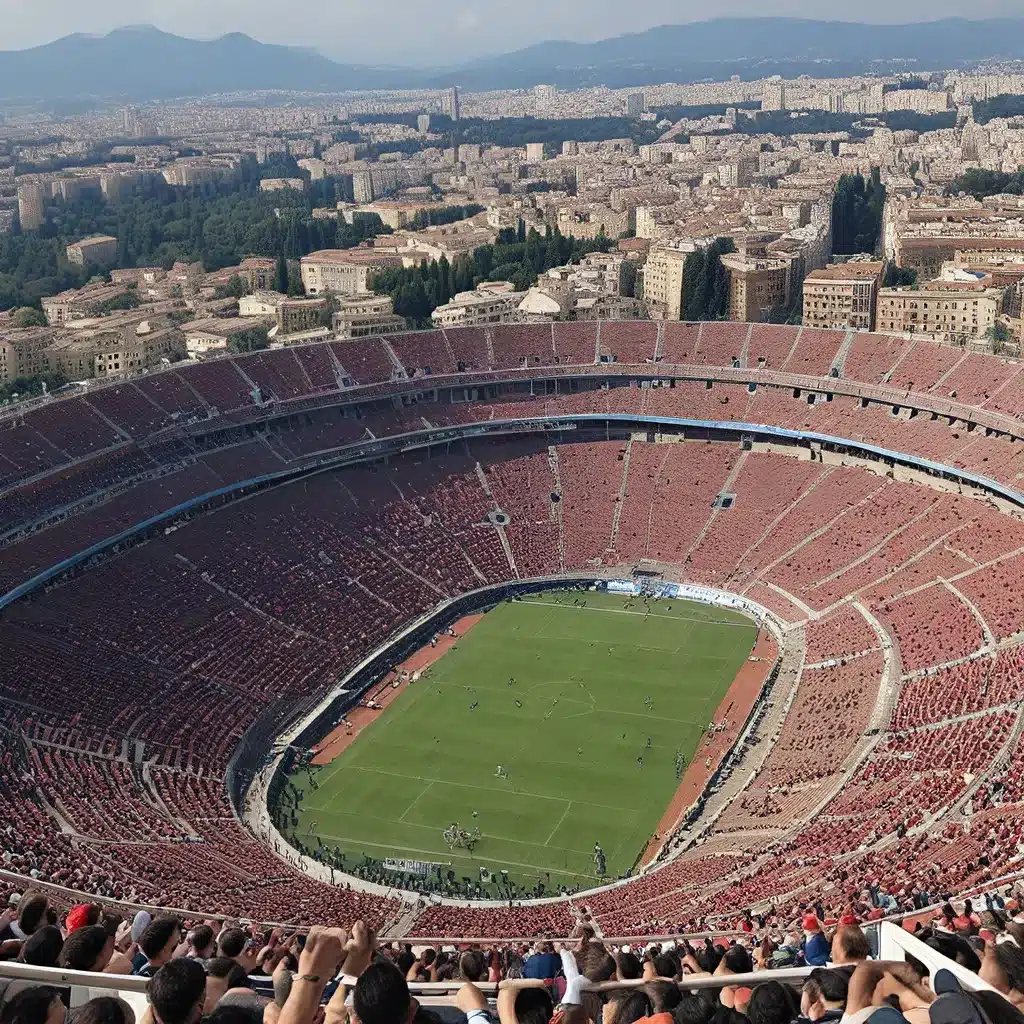
A Storied Venue with a Rich Sporting Legacy
The Stadio Olimpico in Rome, Italy is a multi-purpose sports stadium that has hosted some of the most iconic sporting events in European history. Originally constructed in 1928 and expanded in 1937, this grand arena has been the stage for Olympic Games, World Cup finals, European Championship matches, and countless other prestigious competitions. But beyond its status as a premier football (soccer) venue, the Olimpico has also played a significant role in the development of rugby union in Italy.
The stadium’s roots date back to the fascist regime in Italy, which saw sport as a powerful tool for propaganda. In 1926, the Foro Italico sports complex, including the Stadio dei Cipressi (later renamed the Olimpico), was commissioned by the Opera Nazionale Balilla, a youth organization established by the Fascist government. Construction began in 1928 under the supervision of architect Enrico Del Debbio, with the initial plan calling for a capacity of 100,000 spectators.
Hosting Rugby’s Biggest Moments
Despite its multisport capabilities, the Olimpico was rarely used for anything other than military exhibitions and mass gatherings during the fascist era. However, in 1954, the stadium hosted the final of the fifth Rugby Union European Cup, where France defeated Italy 39-12 in front of an estimated crowd of 25,000. This marked the first time the Olimpico had played host to a major rugby union event.
The stadium’s connection to the sport of rugby would only deepen in the decades that followed. In 1986, the Italian national rugby team played a high-profile match against England at the Olimpico, drawing a crowd of 40,000. This was the first time the Azzurri had played at the venue since 1954, and the match was organized as a fundraiser for children’s aid organizations.
The Olimpico would go on to host the Italian national team’s home games in the Six Nations Championship starting in 2012, replacing the smaller Stadio Flaminio as the primary venue for Italy’s participation in the prestigious tournament. By the end of the 2023 Six Nations season, the Olimpico had played host to 39 test matches involving the Italian national team, solidifying its status as a rugby union stronghold in the country.
Adaptations and Renovations
Over the years, the Olimpico has undergone various renovations and adaptations to keep pace with changing sporting and technological demands. Perhaps the most significant transformation came in the lead-up to the 1990 FIFA World Cup, which Italy was selected to host.
In the five years following Italy’s successful bid, the future of the Olimpico and other Roman stadiums sparked a political and architectural debate. Ultimately, the decision was made to renovate the Olimpico, with architects Vitellozzi, Clerici, Teresi, and Michetti tasked with the project. The plan called for a covered stadium with a capacity of 85,825, achieved through a 6-meter rise of the Tevere and Monte Mario grandstands and the reconstruction of the northern and southern stands.
However, the renovation process was not without its challenges. Environmental organizations filed appeals citing concerns about the impact of the 40-meter roof pillars, leading to delays and a redesign that lowered the height of the structure. The final cost of the renovation was estimated at around 450 billion lire, or approximately $22.5 million at the time.
The renovated Olimpico was completed in April 1990, just two weeks before the start of the World Cup. The new stadium featured a state-of-the-art retractable roof, increased seating capacity, and various other upgrades to meet FIFA’s requirements. The venue went on to host six matches during the 1990 World Cup, including the final, where West Germany defeated Argentina 1-0.
A Multifaceted Sporting and Cultural Venue
In addition to its storied history in rugby and football, the Olimpico has played host to a wide range of other sporting and cultural events over the years. It has been the site of European Championships, UEFA Champions League finals, and even the opening and closing ceremonies of the 1960 Summer Olympics.
The stadium has also become a popular venue for concerts, with world-renowned artists such as Miles Davis, Pat Metheny, Claudio Baglioni, Vasco Rossi, and Depeche Mode having performed there. In 1998, the venue set a record for the highest attendance at a musical event when 82,000 tickets were sold for two concerts by Italian singer-songwriter Claudio Baglioni.
Beyond its sporting and cultural significance, the Stadio Olimpico has also played a role in Italy’s political history. During the fascist era, the stadium was used for military celebrations and mass gatherings, such as a parade to welcome German dictator Adolf Hitler in 1938. In the aftermath of World War II, the stadium’s governance was the subject of a fierce political battle, with the Communist Party accusing the Christian Democracy party of misusing the complex.
A Symbol of Italian National Pride
Today, the Stadio Olimpico remains an iconic landmark in the city of Rome and a symbol of Italian national pride. It continues to host the home matches of the city’s two leading football clubs, SS Lazio and AS Roma, as well as the Italian national rugby team in the Six Nations Championship.
The stadium’s rich history, architectural grandeur, and multifaceted role in sports, culture, and politics have cemented its status as one of the most significant sporting venues in Europe. As the Old Stadium Journey website aptly notes, the Olimpico is a testament to the resilience and evolution of Italy’s sporting landscape, a place where history, tradition, and progress converge to create an unforgettable experience for athletes and fans alike.

